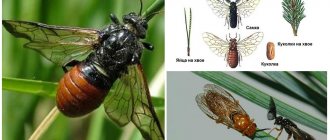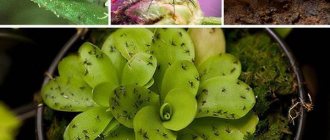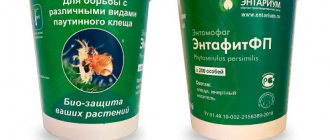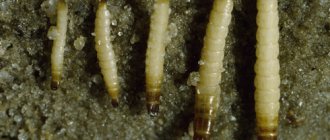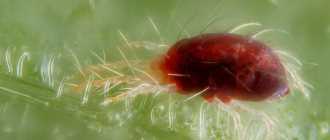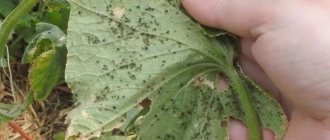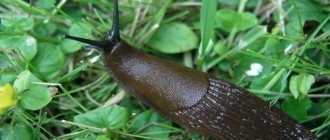Signs and consequences of infection
Spider mites appear on ficus benjamina as follows:
- Initially, the lesion can be noticed on the trunk of the plant - areas affected by a thin whitish web appear on it. Once you have noticed even a relatively small area covered in cobwebs, it is worth inspecting the entire ficus. The pest itself is quite small in size and can only be seen using optical instruments.
Reference. To identify a pest, you can also take a photo using a camera or a regular smartphone, enlarge it and notice the parasites that have settled on the plant.
- The pest then attacks the leaves. They begin to change color from green to marbled, this may appear in small spots, then the affected area increases. The leaves cease to receive sufficient nutrition, soon turn yellow, and then completely fall off.
- The next sign may be a slowdown in the growth of the plant ; outwardly it ceases to look healthy, and if you do not take action, the ficus will simply die.
It is also useful to read: Spider mites on a rose
Photo
These photos show how spider mites manifest themselves on ficus:
It is also useful to read: Spider mites on lemon
Spider mites on ficus benjamina: how to fight
Spider mites can be combated not only with chemicals, but also with biological agents or traditional methods. Biologists note that this is a long process; after a single treatment, the pest cannot be exterminated, so be prepared to repeatedly use several products.
Chemicals
- Actellik - suitable if you have several ficus trees, and all of them have been infected by a pest. To process the plants, you need to take them out of the room into an open space or carry out the procedure in a well-ventilated area.
- Fitoverm - suitable for indoor processing. But after its completion, you need to wash thoroughly in the shower, rinse your mouth, change clothes, and wash your clothes immediately.
- Neoron is an effective remedy. To destroy the pest, double treatment will be sufficient. It destroys not only adults, but also eggs.
- There are also other remedies that will help with plant infection. These include Apollo, Aktofit, Fufanon, Vermitek and others like that.
Biological agents
These products contain predatory mites that eat spider mites directly on the plant. This drug is available for purchase only in flower shops or on the Internet.
- Amblyseius,
- Phytoseiulus.
Reference. These ticks are safe for humans and pets. After eating spider mites, they are deprived of food and then die.
Traditional methods
These are the products that cannot be bought in pharmacies or specialized stores; they are used by experienced flower growers. According to their reviews, these remedies really help get rid of the problem.
- Medical alcohol. There will be no harm to the leaves if they are wiped with medical alcohol, but such a solution is harmful to the parasite. But only adult ticks can die, but alcohol will not affect the eggs; it is better to choose another method.
- Soap. Soapy water is also harmful to the pest. Before this method of processing, the plant along with the pot must be placed in a large basin or bathtub. Apply the soap solution to a sponge and thoroughly wipe the leaves, ficus trunk, pot and the place where the plant is constantly located. The soil also needs to be treated. Then leave the solution on the ficus for several hours, then rinse thoroughly, and cover the flower with a dry bag for about a day, and then remove.
- Onion peel. To prepare such a product, you need to take 100 grams of onion peel, pour 5 liters of water into it, leave for 5 days, then strain, pour into a spray bottle and spray the plant.
- Garlic. Peel two heads of garlic, grind them on a grater or blender, add 1 liter of water and leave for 4-5 days, but for this you need to choose a place protected from sunlight. Then dilute the solution with water in a ratio of 1 to 1 and also apply it to the plant damaged by the pest using a sprayer.
- Chamomile. Dried chamomile flowers can be bought at any pharmacy. Prepare an infusion: pour 1 tablespoon with 1 liter of boiled water, let it brew, then cool and spray the ficus with the resulting infusion.
It is also useful to read: Spider mites on gooseberries
What does a spider mite look like?
Many people find it difficult to believe that the wilting of their favorite ficus is directly related to parasite damage. Spider mites are small in size, their body length does not exceed 0.3-0.6 mm. The shape of insects is usually oblong-oval. Their entire body is covered with small, but quite noticeable hairs, which help them cling to the plant whose juices they feed on. It is impossible to see these insects with the naked eye. You should use a regular magnifying glass, through which you can clearly see them.
Female spider mites are slightly larger than males. All adult ticks have 4 pairs of prehensile legs. Adults lay eggs in large numbers. Given favorable conditions, they ripen in just 3 days. In unfavorable conditions, eggs can survive in the soil for about 5 years. It is precisely because of their survivability that the fight against spider mites is quite protracted. Typically, larvae and adults respond well to the effects of both chemical insecticides and folk remedies. Ticks lay eggs in the soil, on pots and tree stems, as well as other elements.
Parasite eggs can persist for a long time, waiting for favorable conditions for the larvae to emerge. Ticks usually live in colonies, which greatly aggravates the situation, since the young live with their parents and begin to harm the ficus even more.
These insects are brownish or green in color. They move slowly, so it is almost impossible to notice them. Both adults and larvae have a special proboscis, which they use to pierce the leaves and drink the juices of the plant. It is important to know the main symptoms of plant damage by these parasites.
Preventive actions
To keep your ficus trees in order and not get sick, they need to be regularly inspected for infection.
Important! It must be remembered that pests develop in dry air and in the complete absence of wind, that is, in unventilated, dry rooms.
For prevention purposes, you need to:
- Increase air humidity, that is, regularly use humidifiers or simply place containers of water around the house that will help increase the humidity in the room.
- Ficus leaves need to be washed or sprayed especially carefully from the underside.
- In the summer and before the onset of cold temperatures, take the plants out into the fresh air - outside or onto the balcony.
- Determine the habitat of ficus plants near a window or where there is a slight draft. Ficuses are not afraid of the wind.
- Pick off dried leaves and remove those that have fallen from the pot.
- Under no circumstances should you use substrate from infected plants.
- For a new plant in the house, quarantine it for 2-3 weeks, only after that it can be placed next to others.
This way, you will be able to identify diseases in a timely manner, take measures to eliminate them, and subsequently prevent re-infection with spider mites.
How to deal with spider mites on indoor plants at home?
Cobwebs on indoor flowers - what is it? Spider mites infect almost all plants on all continents, except for aquatic ones. This tick lives everywhere, except in Antarctica. It often turns into a real disaster for lovers of indoor flowers.
What are spider mites on houseplants? This is a small insect, elliptical in shape and reaching a size of up to 1 mm. They live in large colonies, nestling under dry leaves left in a pot, or small lumps of soil on the back of a leaf.
…
Want to know more? Subscribe to our public VK page, where all the most delicious things are from the editors and interesting things from the readers:
Such a colony consists of hundreds of ticks; they actively reproduce, laying larvae. Ticks and larvae drink the juice by piercing the leaf and sucking out the liquid from it. Spider mites on indoor plants - how to deal with them?
How to detect?
Spider mites on indoor plants - photo:
Numerous light spots form on the leaves, and if the colony is large, the plant becomes covered with a thin, barely noticeable cobweb (hence the name mite) and very soon begins to dry out.
They can be difficult to detect due to their small size and color, which helps them blend in with the foliage (mites are brownish, greenish and yellowish in color). Females remaining for the winter are red in color.
Female ticks live less than a month, but during this period they are capable of laying hundreds of eggs. New individuals appear in the clutch after three days. The biggest problem is that the eggs remain alive for up to 5 years.
They wait in the wings on the bark, in the axils of the plant, in the soil and even in window frames, on window sills and in chipped flower pots. That is why the fight against them can be long.
Often spider mites are brought from the store, so the new plant must be quarantined for at least two weeks.
Types of ticks
Cobwebs on flowers: what to do? To understand how to remove spider mites from indoor flowers, you need to know that they come in several types:
- common spider mite: its extensive populations settle on the lower parts of leaves and on the tops of young shoots; as the colony grows, individual individuals begin to spread throughout the windowsill, infecting more and more new plants; in a short period of time they can infect the entire collection; most often they affect fuchsias, impatiens, ficuses, roses and dracaenas; the first sign of such a lesion is yellow spots on the leaves and small white cobwebs;
- red mite: most often settles on balsam, rose, nightshade, orchid, lemon; actively reproduces at high air temperatures;
- false tick: dangerous because it is very small in size and not at all visible to the naked eye; it does not weave webs, so the defeat is noticed only when the plant begins to die;
- Atlantic mite: mainly affects exotic palm trees and citrus fruits, but can spread to any plant; one of the few mites that actively spread when indoor humidity is high;
- cyclamen mite: spreads to gloxinia, chrysanthemum, cyclamen, pelargonium, balsam, violet; it lives not only on the leaves, but also in the tubers of plants; large colonies look like a layer of dust; unlike most of its counterparts, it loves high air humidity;
- broad mite: likes to settle on anthurium, euonymus, ficus, saintpaulia, oleander, citrus fruits and cacti; he is very fertile; new colonies appear on the leaves of a diseased plant every 3-4 days; they are easy to spot: red clusters of dust and cobwebs are visible; females do not huddle in hard-to-reach places to lay eggs, so it is easy to fight;
- cactus flat mite (bryobia): affects exotic plants, can be detected by white or yellowish intermittent stripes on the leaves; the female lays large orange eggs, extending chains of them along the veins of the leaf; found on Saintpaulia, Fatsia, can spread to any plant;
- clover mite: it affects ambutylone, ficus, euonymus, peperomia, orchids and various bulbous plants; eats away entire passages, filling them with brown dust.
Houseplants are also attacked by other types of poutine mites: Pacific, strawberry, red (flat) mites.
All ticks are capable of adapting to the most unfavorable conditions and inhibiting vital processes until good conditions for reproduction occur. This state is called diapause.
Read more about these and other types of spider mites in our article “Types of spider mites. How to recognize a harmful parasite?
How to fight at home?
It is difficult to combat spider mites, so it is worth engaging in prevention.
Most types of mites do not like humid air, and plants need to be sprayed more often and the humidity maintained at the desired level in various ways.
Immersing the plant in water rarely helps, because mites are able to form an air bubble around themselves.
The leaves of the plant should be wiped on both sides with a damp soft cloth, which should be constantly rinsed in hot water, so as not to transfer mites from plant to plant. Fallen leaves and flowers should not be left in the pot.
Before reuse, pots must be washed with detergents; it is better to store them in unheated rooms in winter. Wash frames with detergents. Paint wooden frames as often as possible.
Spider mites not only harm the plant themselves, but are also carriers of various diseases, such as gray rot and spores of various fungi.
How to treat flowers against spider mites at home?
The following folk remedies for fighting spider mites are suitable:
- vodka diluted with water;
- infusion of dandelion roots;
- garlic infusion;
- decoction of cyclamen tubers;
- infusion of calendula flowers.
You can learn how to treat indoor flowers against mites using a cyclamen tuber from the video:
Folk remedies cannot always cope, and then you have to resort to stronger drugs:
- "Intavir";
- "Fitoverm";
- "Karbofos";
- "Aktellik";
- "Alatar".
You can read in detail how to use spider mite control products.
All products will be effective only with repeated processing. Neighboring plants, frames and window sills also need to be treated.
Treatment
How to cure flowers from spider mites? If a mite is detected, the plant must first be thoroughly washed with laundry or tar soap. Lather each leaf and each axil, whipping the foam with your hands and carefully working all parts of the plant. Leave the flower for several hours (or for a day), covering it with a plastic bag. Then rinse off the soap thoroughly under a warm shower.
If the lesion was minor, then such a procedure will be sufficient, although it must be repeated two or three times within a week. The plant should be sprayed with warm water twice a day and inspected regularly.
Wash the frames and window sill with hot water and any detergent. The remaining plants on the windowsill also need to be treated for preventive purposes. Spider mites do not tolerate fresh air and ventilation.
What to do if the defeat has gone far enough? You must first treat with soap, then spray with Intavir, Fitoverma, Karbofos. When treating a window, it is also worth adding Karbofos to the water.
Sometimes a fairly simple method helps: place an open container with finely chopped garlic or turpentine near the plant, tightly close the plant along with the container for 2-3 days. The edges of the pot should be lubricated with tar.
Ways to fight flowers
How to get rid of spider mites on indoor flowers? For each plant it is necessary to select an individual control method.
Orchid
Spider mite on an orchid - photo:
The flower is affected by many types of mites, for example, the phalaenopsis mite, which lives in the axils. Spider mites on orchids - how to fight? First, the plant must be washed with soap, then treated with one of the chemicals, it is better to use the non-toxic “Fitoverm” or an aqueous solution of the drug “Actellik”.
Spider mites on an orchid: what are the control measures? To combat mites, special sticks made in Holland are used, which are stuck into the soil in a pot with an orchid. The action of the Plant-pin and Ethisso sticks is based on the following principle: the substance of which they are composed dissolves during watering, is absorbed into the ground and, together with water, is absorbed by the roots, from where it enters the above-ground part of the plant, the flower becomes unsuitable for ticks to feed on. .
After purchase, soil, moss, and orchid pots are treated with boiling water to prevent spider mites.
What an orchid affected by spider mites looks like and how to avoid infesting plants - in this video:
Balsam
Mites often infest balsam trees. If this happens at the end of summer, autumn or winter, then the plant must be radically pruned. Wash the remaining part and treat it with an insecticide, preferably Alatar, since it is very difficult to get rid of mites on balsam.
Spider mites on balsam - how to fight? If infection occurs in spring or summer, the plant is treated with soap foam, then sprayed with insecticide, the procedure is repeated several times after 3-5 days. If the plant is not of particular value, it is better to throw it away and prevent the appearance of mites on other flowers.
Spider mite on balsam - photo:
Indoor rose
How to cure and save a rose from spider mites at home? Spider mites appear constantly on roses indoors, so it is important to carry out prevention. But if the plant is already affected, then treatment must begin as quickly as possible. Are there home remedies for spider mites on roses?
A cobweb appeared on an indoor rose: what to do? First, you need to wash the rose with hot water, up to 50-55 degrees, with dissolved soap. Leave the plant for a day under a plastic bag and then rinse with water at the same temperature.
Then you need to try treatment with garlic infusion. If this does not help, then spray with any chemical, it is better to use Neoron.
How to use a spider mite remedy on a house rose? In each case, when you have to process a flower, you must resort to the help of different chemicals.
Spider mites on an indoor rose - photo:
Spider mites on a home rose: how to fight?
You will learn how to treat a home rose against spider mites by watching the video:
You will get some more useful tips on how to get rid of spider mites on a rose at home from this video:
Ficus
To prevent spider mites, ficus should be sprayed regularly. Spider mites on ficus - how to fight? If infected, thoroughly wipe each leaf on both sides with a well-soaped cloth and, after keeping the plant for a day under a plastic bag, wash off the soap with warm water. Then you need to spray the ficus with an alcohol solution of calendula diluted with water, without missing a single leaf.
Irradiation of leaves with ultraviolet light, which mites cannot tolerate, is effective. Ficus leaves can be coated with an oil-containing preparation and left there for several days.
Spider mites on ficus - photo:
Anthurium
If numerous colonies of mites are found on a plant, you must first wash it with soap and cut out those leaves that are severely affected. Then remove from the pot, inspect the roots, remove damaged ones, carefully rinse the roots in warm water and replant in a clean container in new soil.
After this, spray the plant with epin. As a rule, such treatment is sufficient.
But if it is not possible to get rid of ticks in this way, then you will have to resort to spraying with more toxic drugs, for example, “Karate”.
Spider mites on anthurium - photo:
Violet
Most often, violets (Saintpaulias) are affected by the cyclamen mite. Trim the affected leaves, then spray the flower with the drug “Fitovern”, repeat the treatment twice after 10 days.
Spider mite on a violet - photo:
Dracaena
The plant is attacked by a simple spider mite. The fight against it consists of washing the long leaves in warm water and soap.
If after repeated water procedures the mite still remains, then you need to resort to an insecticide. For example, to “Fitoverm”.
Spider mite on dracaena - photo:
The most effective prevention of spider mites on any indoor plant is washing in a warm shower with laundry or tar soap.
See inaccuracies, incomplete or incorrect information? Do you know how to make an article better?
Would you like to suggest photos on the topic for publication?
Please help us make the site better! Leave a message and your contacts in the comments - we will contact you and together we will make the publication better!
rusfermer.net

